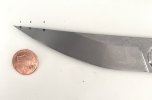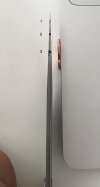- Joined
- Feb 21, 2022
- Messages
- 25
Looking for feedback about the tip of this knife design. It is fresh off milling and you should be aware of a couple things. 1, I mismeasured and it will have an extra 0.02 thickness across the whole knife once I remake it. 2, I'm going for more of a light edc/collector function than a hard use blade. 3, In it's annealed state (30 HRC?), the tip flexes under finger pressure.
-Steel - 1095 (Switching to A2 shortly)
-Blade Length - 3.7"
-Spine - 0.125" (I made an error, but ultimately the thickness would be 0.145". For reference, the spyderco paramilitary is 0.140")
-Grind - Flat, although spine does not follow to tip
Questions:
-I've made 3 marks on the blade tip. 1st mark to tip is 0.026" thick at the spine. 2nd mark is 0.044" at the spine. 3rd mark is 0.074" at the spine. Is this acceptable for any function? Again, all of this will have an extra .002 when I redo it.
-Any rules of thumb you stick to determining thickness/length to tip/angle?
-Will this design work for A2 or any other steel, or should I just increase the entire overall thickness to at least 0.16?
-Steel - 1095 (Switching to A2 shortly)
-Blade Length - 3.7"
-Spine - 0.125" (I made an error, but ultimately the thickness would be 0.145". For reference, the spyderco paramilitary is 0.140")
-Grind - Flat, although spine does not follow to tip
Questions:
-I've made 3 marks on the blade tip. 1st mark to tip is 0.026" thick at the spine. 2nd mark is 0.044" at the spine. 3rd mark is 0.074" at the spine. Is this acceptable for any function? Again, all of this will have an extra .002 when I redo it.
-Any rules of thumb you stick to determining thickness/length to tip/angle?
-Will this design work for A2 or any other steel, or should I just increase the entire overall thickness to at least 0.16?
Attachments
Last edited:


